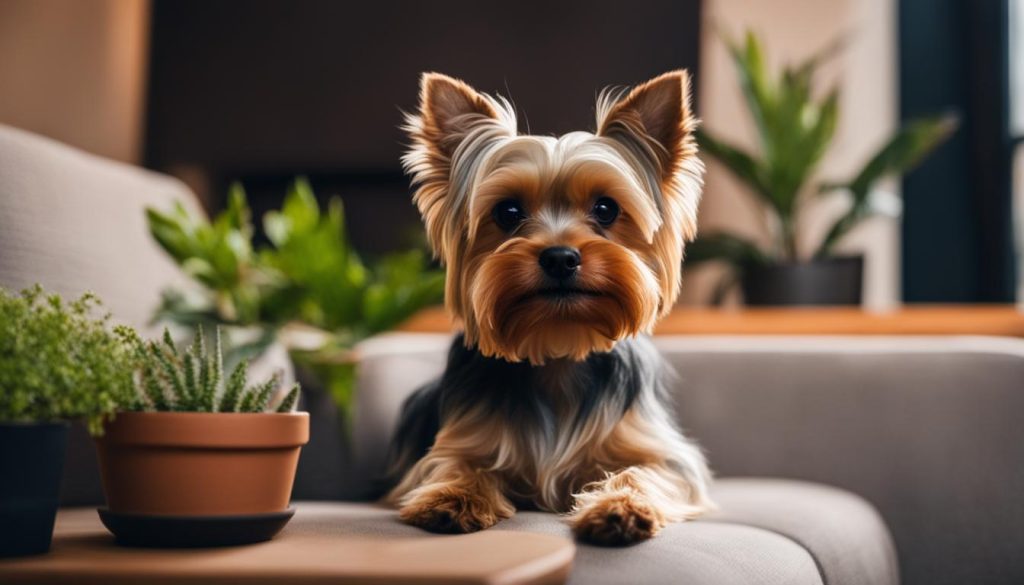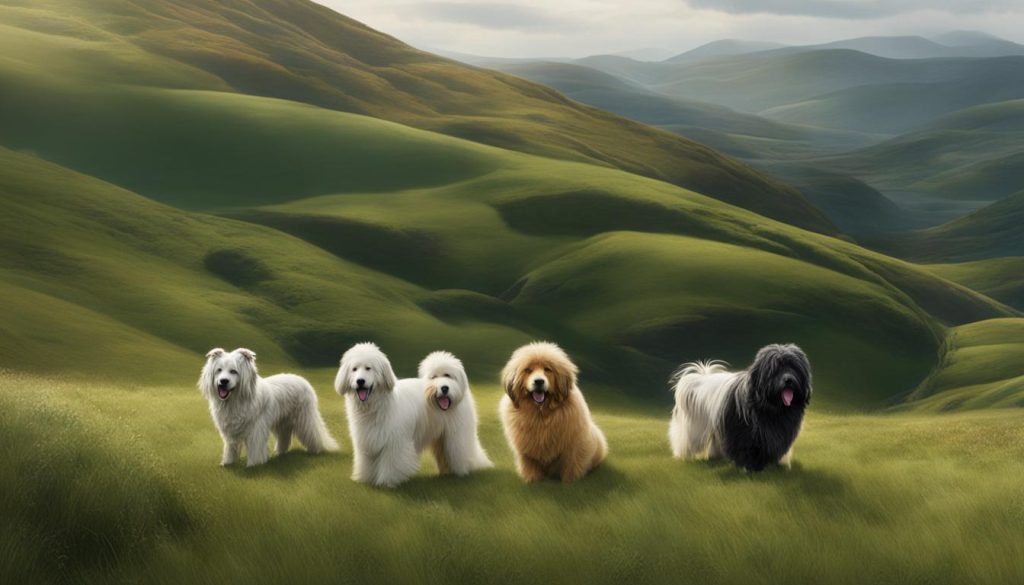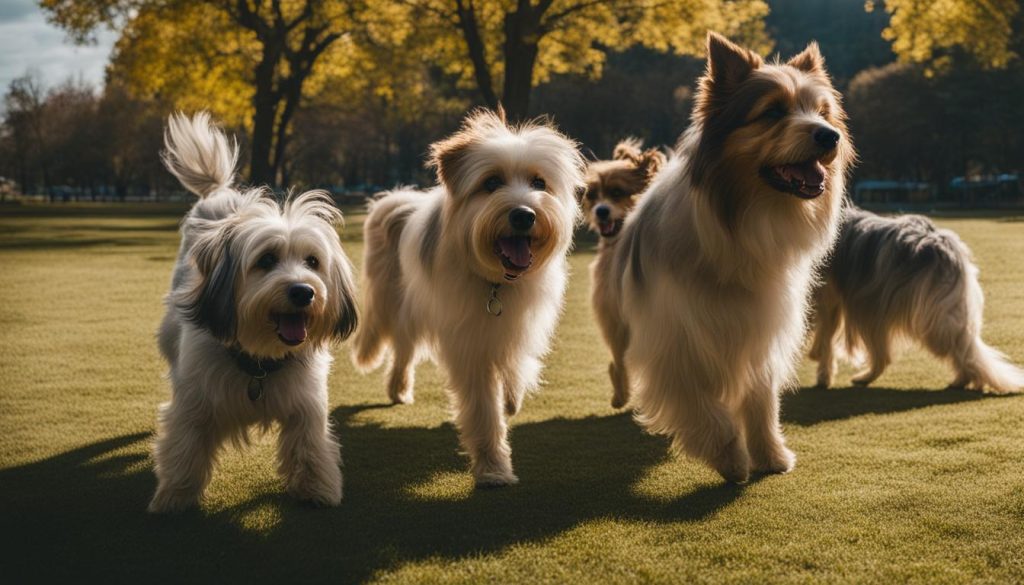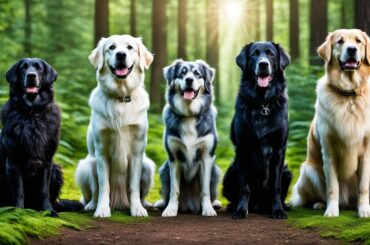Shaggy dog breeds, also known as shaggy-haired or long-haired dog breeds, are beloved for their fluffy coats that add a charming and adorable touch to their appearance. In this comprehensive guide, I will introduce you to some of the best shaggy dog breeds available, highlighting their unique traits and care needs. Whether you’re looking for a small or large shaggy companion, this guide will help you find the perfect furry friend for your home.
Key Takeaways:
- Shaggy dog breeds have fluffy, long-haired coats that are both soft and adorable.
- Grooming requirements for shaggy dog breeds can be high, with daily brushing and regular visits to the groomers.
- Some shaggy dog breeds may struggle in warm climates and require extra care during the heat.
- There are shaggy dog breeds suitable for small living spaces, such as apartments.
- The Pomeranian, Yorkshire Terrier, and Bichon Frise are popular small shaggy dog breeds.
What Makes Shaggy Dog Breeds Appealing?
Shaggy dog breeds have an undeniable appeal due to their fluffy coats that are soft, cuddly, and invoke feelings of warmth and happiness. The charm of these breeds lies in their adorable appearance, which often attracts dog lovers. However, owning a shaggy dog breed comes with certain responsibilities, particularly in terms of grooming requirements and shedding.
Grooming is a significant aspect of owning a shaggy dog breed. These breeds typically require daily brushing to prevent matting and keep their fur in good condition. Additionally, regular visits to the groomers are necessary to maintain their coats and overall hygiene. It’s important to devote time and effort to grooming these breeds to ensure their well-being and keep them looking their best.
Shedding is another consideration for potential owners of shaggy dog breeds. While the fluffy coats may seem delightful, some breeds shed heavily. This means that regular vacuuming and cleaning will be necessary to manage the fur. However, the appeal of shaggy dog breeds and their lovable personalities often outweigh the extra maintenance required.
Grooming Requirements: A Brief Comparison
| Breed | Grooming Needs | Shedding Level |
|---|---|---|
| Shih Tzu | Requires daily brushing and regular grooming. | Sheds moderately. |
| Old English Sheepdog | Requires daily brushing and weekly grooming. | Sheds heavily, with seasonal shedding. |
| Maltese | Requires daily brushing and regular grooming. | Sheds very lightly. |
“The fluffiness and cuteness of shaggy dog breeds continue to be a major attraction for dog lovers.”
Despite the grooming requirements and shedding, shaggy dog breeds remain popular due to their unique charm and cuteness. The joy and happiness they bring to their owners often outweigh the maintenance involved. If you are prepared to dedicate time and effort to their care, a shaggy dog breed can be a wonderful companion and a beloved member of your family.
Shaggy Dog Breeds in Warm Climates

While shaggy dog breeds are often associated with cold climates, it’s essential to consider their adaptability to warm climates as well. Some shaggy dog breeds may struggle in hotter regions, especially during the summer months when they are more prone to overheating. Extra care and precautions should be taken during this time to ensure their well-being and prevent any heat-related issues.
In warm climates, it’s crucial to provide shaggy dog breeds with a cool and comfortable environment. Here are some tips to help them beat the heat:
- Provide access to shade: Create shady areas in your yard or set up a canopy to protect your shaggy friend from direct sunlight.
- Stay hydrated: Keep fresh water available at all times and consider using a pet fountain to encourage drinking.
- Avoid midday walks: Schedule your walks during cooler times of the day, such as early morning or late evening, to prevent overheating.
- Use cooling products: Invest in cooling mats, bandanas, or vests designed specifically for dogs to help regulate their body temperature.
“It’s important to pay attention to signs of heat exhaustion or heatstroke in shaggy dog breeds,” says Dr. Sarah Collins, a veterinarian specializing in canine health. “Symptoms may include excessive panting, drooling, lethargy, vomiting, or collapse. If you notice any of these signs, move your dog to a cool area immediately and contact your veterinarian.”
By taking these precautions and closely monitoring your shaggy companion’s well-being, you can ensure they stay comfortable and safe even in warm climates. Remember to consult with your veterinarian for additional advice tailored to your specific breed and location.
| Shaggy Dog Breeds Suitable for Warm Climates | Adaptability to Warm Climates | Grooming Requirements | Size |
|---|---|---|---|
| Golden Retriever | Moderate | Regular brushing to manage shedding | Large |
| Afghan Hound | Low | Regular brushing to prevent matting | Large |
| Portuguese Water Dog | High | Regular grooming to maintain coat cleanliness | Medium |
While some shaggy dog breeds may require more upkeep and care in warm climates, there are still options available for those who love the charm of these fluffy companions. Always consider the specific needs of the breed and consult with reputable breeders or adoption centers to find a shaggy dog that is suitable for your climate and lifestyle.
Best Shaggy Dog Breeds for Small Spaces

If you live in a small space or apartment, you may be wondering if shaggy dog breeds are suitable companions. The good news is that there are shaggy dog breeds that can thrive in smaller living environments. These breeds are often smaller in size, making them more adaptable to limited space. Some of the best shaggy dog breeds for small spaces include the Pomeranian, Yorkshire Terrier, and Bichon Frise.
Pomeranian
- Size: Small
- Coat: Double coat, fluffy and thick
- Temperament: Extroverted and energetic
- Grooming Needs: Regular brushing to prevent matting
Yorkshire Terrier
- Size: Small
- Coat: Long, silky, and straight
- Temperament: Confident and loyal
- Grooming Needs: Regular brushing and occasional professional grooming
Bichon Frise
- Size: Small
- Coat: Curly and fluffy, white in color
- Temperament: Affectionate, playful, and curious
- Grooming Needs: Regular brushing and regular visits to the groomer
These shaggy dog breeds are not only adorable but also well-suited for smaller living spaces. Their smaller size makes them more comfortable in apartments and houses with limited space. Despite their shaggy coats, these breeds can be kept clean and tidy with regular grooming and brushing. They are also known for their friendly and affectionate temperaments, making them great companions for individuals or families in small spaces.
When considering a shaggy dog breed for a small space, it’s important to remember that all dogs need exercise and mental stimulation. Regular walks, playtime, and mental exercises are essential for their well-being, regardless of their size or living environment. Providing a balanced diet and regular veterinary care is also crucial for their overall health and happiness.
| Breed | Size | Coat | Temperament | Grooming Needs |
|---|---|---|---|---|
| Pomeranian | Small | Double coat, fluffy and thick | Extroverted and energetic | Regular brushing to prevent matting |
| Yorkshire Terrier | Small | Long, silky, and straight | Confident and loyal | Regular brushing and occasional professional grooming |
| Bichon Frise | Small | Curly and fluffy, white in color | Affectionate, playful, and curious | Regular brushing and regular visits to the groomer |
Shaggy Dog Breeds: Top 3 Small Breeds

The Bichon Frise is a small and sturdy shaggy dog breed with a curly, fluffy white coat. They are known for their friendly and affectionate nature, making them wonderful family pets. Bichon Frises are playful, sociable, and love to be the center of attention. They are great with children and other pets, and their compact size makes them ideal for apartment dwellers. Bichon Frises require regular grooming to maintain their coat’s fluffiness and prevent matting. With their cheerful disposition and adorable appearance, Bichon Frises bring joy and companionship to any home.
| Breed | Description |
|---|---|
| Pomeranian | Small, extroverted, and energetic breed with an abundant double coat. Known for their bold and outgoing personality. |
| Yorkshire Terrier | Small and toy-sized breed with a long, silky, straight coat. Confident, affectionate, and highly trainable. |
| Bichon Frise | Small and sturdy breed with a curly, fluffy white coat. Friendly, sociable, and great with children and other pets. |
Shaggy Dog Breeds: Top 3 Medium Breeds
If you’re considering a medium-sized shaggy dog breed, you have several wonderful options to choose from. These breeds offer a perfect balance of size and fluffiness, making them a popular choice for many dog lovers. In this section, we will explore the top three medium shaggy dog breeds: the American Eskimo Dog, the Havanese, and the Shetland Sheepdog.
American Eskimo Dog
The American Eskimo Dog is known for its medium-length double coat, which provides them with a beautiful and fluffy appearance. With their friendly and open nature, they make excellent family pets and are often great with children. These intelligent dogs require regular mental and physical stimulation to keep them happy and engaged.
Havanese
The Havanese is a sociable and energetic toy breed that features a thick, soft, and silky coat. They have a friendly and affectionate temperament, making them wonderful companions for individuals or families. Havanese dogs are highly adaptable and can thrive in various living environments, including apartments and houses with yards.
Shetland Sheepdog
The Shetland Sheepdog, also known as the Sheltie, possesses herding instincts and a shaggy coat that adds to their charm. They are intelligent and eager to please, making them easy to train. Shelties are known for their loyalty and make excellent family pets, providing companionship and protection to their loved ones.
| Medium Shaggy Dog Breeds | Coat | Temperament | Size |
|---|---|---|---|
| American Eskimo Dog | Medium-length double coat | Friendly and open | 15-20 inches (38-51 cm) |
| Havanese | Thick, soft, and silky coat | Sociable and energetic | 8.5-11.5 inches (22-29 cm) |
| Shetland Sheepdog | Shaggy coat | Intelligent and loyal | 13-16 inches (33-41 cm) |
Shaggy Dog Breeds: Top 3 Large Breeds

When it comes to large shaggy dog breeds, there are a few standout options that offer both size and fluffiness. These breeds make excellent companions for those seeking a furry friend with a big personality and an even bigger coat. Let’s explore the top three large shaggy dog breeds.
Australian Shepherd
The Australian Shepherd is a highly intelligent and active breed known for its striking appearance and versatile working abilities. With their medium-length double coats, Australian Shepherds require regular brushing to keep their fur looking its best. They come in a variety of coat colors and patterns, making each one unique. These dogs thrive in active households and excel at activities such as herding, agility, and obedience training. Their loyal and friendly nature also makes them wonderful family pets.
Old English Sheepdog
The Old English Sheepdog, often referred to as the “Bobtail” due to their docked tails, is instantly recognizable with its iconic shaggy coat. This breed is known for its gentle and friendly demeanor, making them excellent companions for families. While their coat requires regular grooming to prevent matting, their lovable personality and adaptability make the grooming process a labor of love. With proper care and socialization, the Old English Sheepdog can be a fantastic addition to any home.
Samoyed
The Samoyed, with its white fluffy coat and endearing smile, is a breed that captures the hearts of many. Known for their friendly and sociable nature, Samoyeds are often referred to as “smiling sled dogs.” Despite their majestic appearance, Samoyeds have a playful and mischievous side, making them a joy to be around. While their thick coat requires regular grooming to manage shedding, the love and companionship they provide more than make up for the extra effort.
| Breed | Coat Type | Temperament |
|---|---|---|
| Australian Shepherd | Medium-length double coat | Intelligent, loyal, and active |
| Old English Sheepdog | Thick and shaggy coat | Gentle, friendly, and adaptable |
| Samoyed | Thick and fluffy white coat | Friendly, sociable, and playful |
Caring for Shaggy Dog Breeds
Proper care is essential for shaggy dog breeds to keep their coats healthy and maintain their overall well-being. Here are some key aspects to consider when caring for these furry companions:
Grooming
Grooming is a crucial part of caring for shaggy dog breeds. Regular brushing helps prevent matting and tangling of their long, fluffy coats. It also helps distribute natural oils, keeping their fur healthy and shiny. Depending on the breed, daily brushing may be necessary to keep their coats looking their best. Consider investing in high-quality grooming tools, such as slicker brushes and detangling combs, to make the process easier.
Exercise
Despite their adorable appearance, shaggy dog breeds have energy to burn. They require regular exercise to keep them physically and mentally stimulated. Long walks, playtime in the yard, or interactive games such as hide and seek can all help meet their exercise needs. Engaging in regular exercise not only keeps them fit but also helps prevent behavioral issues that can arise from pent-up energy.
Nutrition
A well-balanced and nutritious diet is vital for the health of shaggy dog breeds. Consult with your veterinarian to determine the appropriate type and amount of food for your furry friend. Consider their age, size, activity level, and any specific dietary needs they may have. High-quality commercial dog food, supplemented with fresh fruits and vegetables, can provide the necessary nutrients for their well-being. Avoid feeding them table scraps or foods that may be harmful to dogs, such as chocolate, grapes, or onions.
| Grooming | Exercise | Nutrition |
|---|---|---|
| Regular brushing to prevent matting and tangling | Provide regular exercise to keep them fit | Feed a well-balanced and nutritious diet |
| Invest in high-quality grooming tools | Engage in long walks, playtime, and interactive games | Consult with a veterinarian for appropriate dietary recommendations |
| Consider professional grooming for specific breeds | Prevent behavioral issues from pent-up energy | Avoid feeding harmful foods |
“Regular grooming, exercise, and a nutritious diet are essential for the well-being of shaggy dog breeds.”
By taking the time to properly care for your shaggy dog breed, you can ensure they lead a happy and healthy life. Regular grooming, exercise, and a nutritious diet will help keep their coats fluffy and their spirits high. Remember to consult with your veterinarian for breed-specific care tips and any specific needs your furry friend may have.
Shaggy Dog Breeds as Family Pets

Shaggy dog breeds can make wonderful family pets due to their friendly and affectionate temperaments. These breeds often thrive in busy households where they can be active participants in family life. Whether you have children, other pets, or live in a multi-generational household, shaggy dog breeds are known for their adaptability and ability to bond with their human family members.
One of the key factors to consider when choosing a shaggy dog breed as a family pet is their temperament. These breeds tend to be patient, gentle, and good-natured, making them suitable companions for children of all ages. They are often tolerant of handling and enjoy being part of family activities, whether it’s playing in the backyard or snuggling up on the couch for a movie night.
Please be aware that while shaggy dog breeds are generally good with children, proper socialization and training are still necessary to ensure a harmonious relationship. Teaching children how to interact respectfully with their furry friends and providing consistent training for the dog will help establish boundaries and create a positive environment for everyone involved.
Grooming Considerations
When considering shaggy dog breeds as family pets, it’s crucial to take their grooming needs into account. Shaggy coats require regular maintenance to prevent matting and keep them clean and healthy. Depending on the breed, this may involve daily brushing, occasional grooming appointments, and regular bathing.
While grooming can be a bonding experience between the dog and their human family members, it’s essential to ensure that everyone in the household is comfortable and knowledgeable about the grooming process. Teaching children how to brush the dog’s fur gently and rewarding them for positive interactions will help create a positive association with grooming activities.
Choosing the Right Breed
When selecting a shaggy dog breed as a family pet, it’s crucial to consider the breed’s specific characteristics and needs. Factors such as size, energy level, exercise requirements, and compatibility with other pets should all be taken into account. Conducting research, consulting with reputable breeders or rescue organizations, and meeting different breeds in person can help you make an informed decision.
Remember that every dog is an individual, and while breed characteristics can provide a general idea of what to expect, there can always be variations within a breed. Spending time with a prospective furry family member, asking questions, and observing their behavior can give you valuable insights into whether they will be a good fit for your family dynamic.
Finding Your Perfect Shaggy Companion
Choosing the right shaggy dog breed for you and your lifestyle is an important decision. With so many options available, it’s essential to consider factors such as size, grooming requirements, and temperament. To help you make an informed choice, take advantage of breed selector quizzes that can provide personalized recommendations based on your answers.
These quizzes typically ask questions about your living situation, activity level, and preferences in terms of a dog’s size and energy levels. By taking the time to answer these questions honestly, you can receive tailored suggestions that align with your specific needs.
When using a breed selector quiz, keep in mind that the results should be used as a starting point for your research. Take the suggested breeds and dive deeper into learning about their characteristics, care needs, and potential challenges. This will help you evaluate whether a particular shaggy dog breed is truly the right fit for you.
Remember, selecting a shaggy dog breed is not just about their appearance but also about finding a companion that suits your lifestyle and can thrive in your home environment. By using breed selector quizzes as a starting point, you can narrow down your options and embark on a journey of finding the perfect shaggy companion for you and your family.
Table: Shaggy Dog Breed Selector Quiz Results
| Question | Option A | Option B | Option C |
|---|---|---|---|
| Living Environment | Apartment or small house | Suburban or rural area with a backyard | Large property or farm |
| Activity Level | Low to moderate | Moderate to high | High to very high |
| Grooming | Minimal grooming needs | Regular brushing and occasional grooming appointments | High grooming needs including daily brushing |
| Size | Small to medium | Medium to large | Large to extra large |
| Temperament | Calm and laid-back | Energetic and playful | Active and highly intelligent |
Wrapping Up
Shaggy dog breeds offer a unique charm and companionship that is hard to resist. Whether you prefer small, medium, or large breeds, there are shaggy dog breeds to suit a variety of preferences and lifestyles.
When considering a shaggy dog breed, remember to take into account grooming needs, adaptability to climate, and their suitability as a family pet. Proper care and attention are essential to ensure their well-being and keep their coats healthy.
With their fluffy and adorable appearance, shaggy dog breeds can bring joy and happiness to your home for years to come. They make loyal and loving companions, adding a special warmth to your family life. So, if you’re ready for a furry friend that will melt your heart, a shaggy dog breed may be the perfect choice.
FAQ
What makes shaggy dog breeds appealing?
Shaggy dog breeds are beloved for their fluffy, long-haired coats that give them a charming and adorable appearance. The soft and cuddly coats of these breeds evoke feelings of warmth and happiness.
Do shaggy dog breeds have high grooming requirements?
Yes, shaggy dog breeds often come with high grooming requirements, such as daily brushing and regular visits to the groomers. Some breeds also shed heavily, requiring a good vacuum cleaner to manage the fur.
How do shaggy dog breeds fare in warm climates?
Some shaggy dog breeds may struggle in hotter regions, especially during the summer months when they are more prone to overheating. Extra care and precautions should be taken during this time to ensure their well-being and prevent any heat-related issues.
Are there shaggy dog breeds suitable for small spaces?
Yes, there are shaggy dog breeds that can thrive in smaller living environments. Breeds like the Pomeranian, Yorkshire Terrier, and Bichon Frise are well-suited for small spaces.
What are some top small shaggy dog breeds?
Some top small shaggy dog breeds include the Pomeranian, Yorkshire Terrier, and Bichon Frise. These breeds have unique traits and personalities that make them great companions.
What are some top medium shaggy dog breeds?
Some top medium shaggy dog breeds include the American Eskimo Dog, Havanese, and Shetland Sheepdog. These breeds are known for their friendly and sociable nature.
What are some top large shaggy dog breeds?
Some top large shaggy dog breeds include the Australian Shepherd, Old English Sheepdog, and Samoyed. These breeds are known for their unique coats and friendly temperaments.
How do I care for shaggy dog breeds?
Proper care for shaggy dog breeds includes regular grooming, such as brushing and bathing, to prevent matting and keep their fur clean. They also require regular exercise and a balanced diet for overall health and vitality.
Are shaggy dog breeds suitable as family pets?
Shaggy dog breeds can make wonderful family pets due to their friendly and affectionate temperaments. They thrive in busy households and can be active participants in family life.
How can I find the perfect shaggy companion?
When looking for the perfect shaggy dog breed, consider your lifestyle, living environment, and preferences in terms of size, grooming requirements, and temperament. Breed selector quizzes can also provide personalized recommendations based on your answers.






